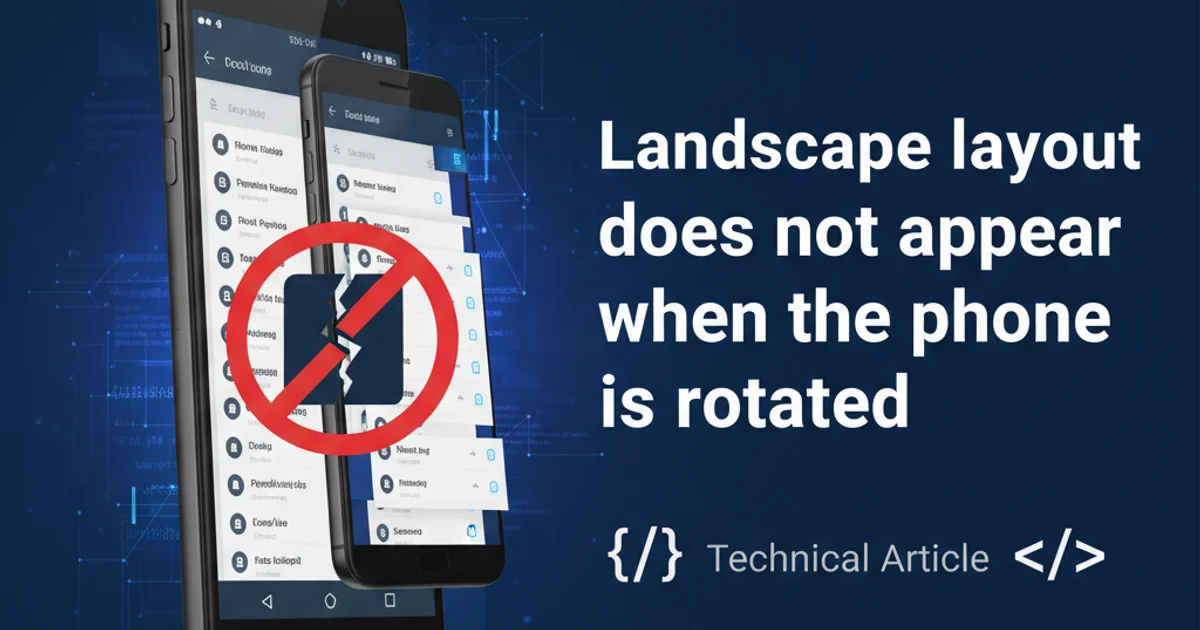Landscape layout does not appear when the phone is rotated
Categories:
Resolving Android Landscape Layout Issues on Phone Rotation

Discover common reasons why your Android app's landscape layout might not appear when the phone is rotated and learn how to fix them.
Developing Android applications often involves supporting various screen orientations, primarily portrait and landscape. A common issue developers encounter is when an app fails to display its intended landscape layout upon device rotation. This can lead to a poor user experience, as content might be cut off, stretched, or simply not optimized for the wider view. This article will explore the primary causes for this behavior and provide practical solutions to ensure your app gracefully adapts to landscape orientation.
Understanding Android's Orientation Handling
Android handles screen orientation changes by default, often recreating the current Activity. This recreation process allows the system to load appropriate resources, such as different layouts defined in res/layout-land/ directories. However, if not configured correctly, this default behavior can be overridden or mismanaged, preventing the landscape layout from being loaded.
flowchart TD
A[User Rotates Device] --> B{Android Detects Orientation Change}
B --> C{Activity Configuration Change?}
C -->|Yes| D[Activity is Destroyed]
D --> E[Activity is Recreated]
E --> F{Loads Layout from `res/layout-land/` if available}
C -->|No| G[Activity Configuration Handled Manually]
G --> H{`onConfigurationChanged()` Called}
H --> I[Developer Handles Layout Update Manually]Android Activity Lifecycle during Orientation Change
Common Causes and Solutions
Several factors can prevent your landscape layout from appearing. Understanding these will help you diagnose and resolve the issue efficiently.
1. Missing Landscape Layout Resources
The most straightforward reason is often the simplest: you haven't provided a specific landscape layout. Android relies on resource qualifiers to select the most appropriate resources for the current device configuration. For landscape, this means creating a layout file in a directory named layout-land.
1. Create layout-land Directory
In your Android project's res directory, create a new directory named layout-land. This directory will house your landscape-specific layout files.
2. Create Landscape Layout File
Inside the layout-land directory, create a layout XML file with the exact same name as its portrait counterpart (e.g., activity_main.xml). Android will automatically pick this file when the device is in landscape mode.
3. Design Landscape Layout
Populate this new activity_main.xml (in layout-land) with your desired landscape-optimized UI. This might involve different LinearLayout orientations, ConstraintLayout constraints, or different ImageView scaling.
2. android:screenOrientation in Manifest
If you explicitly set android:screenOrientation for your Activity in AndroidManifest.xml, you might be preventing the system from rotating the screen or loading alternative layouts. Common values like portrait or landscape will lock the orientation, while sensorPortrait or sensorLandscape allow rotation but might still restrict to a primary orientation.
<activity
android:name=".MainActivity"
android:screenOrientation="portrait" />
Incorrect android:screenOrientation setting that locks the screen to portrait.
android:screenOrientation to portrait or landscape if you intend to support both orientations. If you must control orientation, consider sensor or fullSensor for maximum flexibility.3. Handling Configuration Changes Manually
Another common pitfall is declaring android:configChanges="orientation|screenSize" in your AndroidManifest.xml for an Activity. While this prevents the Activity from being recreated on orientation changes (which can be useful for performance or state preservation), it also means you are responsible for manually updating the UI when the orientation changes. If you don't implement onConfigurationChanged(), your layout won't update.
<activity
android:name=".MainActivity"
android:configChanges="orientation|screenSize" />
Activity declaration indicating manual handling of orientation and screen size changes.
import android.content.res.Configuration;
import android.os.Bundle;
import androidx.appcompat.app.AppCompatActivity;
public class MainActivity extends AppCompatActivity {
@Override
protected void onCreate(Bundle savedInstanceState) {
super.onCreate(savedInstanceState);
setContentView(R.layout.activity_main);
// Initialize UI components
}
@Override
public void onConfigurationChanged(Configuration newConfig) {
super.onConfigurationChanged(newConfig);
// Checks the orientation of the screen
if (newConfig.orientation == Configuration.ORIENTATION_LANDSCAPE) {
setContentView(R.layout.activity_main_landscape); // Load specific landscape layout
// Or update existing views to adapt to landscape
} else if (newConfig.orientation == Configuration.ORIENTATION_PORTRAIT) {
setContentView(R.layout.activity_main); // Load specific portrait layout
// Or update existing views to adapt to portrait
}
// Re-initialize UI components if necessary after setContentView
}
}
Example of onConfigurationChanged() implementation to manually handle layout updates.
android:configChanges, remember that setContentView() in onConfigurationChanged() will replace the entire view hierarchy. You might need to re-find your views and re-bind data after calling it.4. Programmatic Orientation Control
Sometimes, developers programmatically control the screen orientation using setRequestedOrientation(). If this method is called with a fixed orientation (e.g., ActivityInfo.SCREEN_ORIENTATION_PORTRAIT), it will override any manifest settings and prevent rotation, thus never triggering the landscape layout.
import android.content.pm.ActivityInfo;
// Inside an Activity method, e.g., onCreate()
setRequestedOrientation(ActivityInfo.SCREEN_ORIENTATION_PORTRAIT);
Programmatically locking the screen to portrait.
setRequestedOrientation(). Remove or conditionally apply them if you intend to support dynamic orientation changes.Conclusion
Ensuring your Android application correctly displays landscape layouts is crucial for a robust user experience. By systematically checking for missing layout-land resources, incorrect android:screenOrientation manifest entries, unintended android:configChanges declarations, and programmatic orientation locks, you can effectively troubleshoot and resolve most landscape layout issues. Always prioritize the default Android behavior of Activity recreation for orientation changes unless you have a strong reason to handle them manually, and if you do, ensure your onConfigurationChanged() method is correctly implemented.